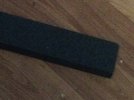wade7575, thanks again for your detailed info.

I always like to know all my sharpening options and didn't know much about these kinds of abrasives.
I am especially interested in the OCB resin stones which produce both toothy and polished edges. I usually carry a second 4.5" blade for redundancy but my primary knives for wilderness use are wood-chopping knives with around 10" blades. I like their great versatility, especially with a finger choil, and low weight and bulk compared to most other chopping tools, since I try to keep my pack weight down. The problem is that wood-chopping requires a smooth edge but I like a toothy edge for everything else, so am always trying to find a compromise. I will definitely check out the OCB resin 400, and the others as well.
That's interesting since the dmt X coarse plate is 220 grit and their XX coarse is 120 grit.?? If you want s fast cutting diamond plate that would be it. My x coarse leaves deep scratches that I have to work out. Whereas, my coarse SiC not so much. DM
Yes, I was surprised there's not a lot of difference between the DMT coarse stones: XXC - 120 mesh, XC - 220 mesh, C - 325 mesh (DMT uses "mesh" instead of "grit", probably to avoid the confusion caused by the different grit standards, but I think in this case they are at least close)
I was disappointed the XXC did not hog off metal as fast as I thought it would (patience isn't one of my strong points when it comes to freehand reprofiling) but didn't know until after I bought it that it shouldn't be used with much pressure. I was then curious how quickly stones could remove metal
with pressure (within reason). This led to favoring silicon carbide for reprofiling, but at lower grits than most people seem to use, to speed up the process as much as possible. I still like diamonds to finish with and usually use 120-140 grit, then 325-400 for a toothy edge.

 I always like to know all my sharpening options and didn't know much about these kinds of abrasives.
I always like to know all my sharpening options and didn't know much about these kinds of abrasives.